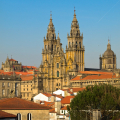SAINT JAMES DE COMPOSTELLE CATHEDRAL
Cathedral in front of the city hall with a high tower of almost 80 m and a huge censer of 80 kg
"At the end of the road, the cathedral. "Traditionally, when pilgrims reached the top of the hill overlooking Santiago in the east and finally saw the goal of their journey, they fell to their knees and made a large sign of the cross, crying out "Montjoie! ». It was therefore quite natural that this hill was called Monte del Gozo (Mount of Joy). It was only a few minutes' walk before they reached the cathedral.
Before entering, if not on your knees, then at least in a frenzy, it is worthwhile to appreciate the many facades. The Puerta de las Platerías (Goldsmiths' Gate), the oldest, has a porch with double Romanesque arches finely sculpted in the manner of Sangüesa and Leyre. On the right, the Clock Tower was built at the end of the 17th century. The present cathedral is almost entirely from the 11th and 12th centuries, following the first basilica, built over the tomb of the Apostle shortly after his discovery, and that of Alfonso III, which was destroyed in 997 by the raid of the Muslim vizier of Córdoba, Al-Mansur. Around the 18th century, the city's wealthy clergy undertook an ambitious series of major works: the façade of the Obradoiro, opposite the Town Hall, is the finest example. Designed as a stone altarpiece by a Santiago architect, Fernando Casas y Novoa, this monumental feat of Compostela's baroque style projects its high towers to almost 80 metres. The staircase, equally imposing, leads to the foot of the Portal of Glory, cleverly hidden behind heavy doors. The debauchery of classicism is replaced here by the ecstatic harmony of the novel. With the theme "apocalyptic glory of the Last Judgement", the brilliant statuary designed by Master Mateo towards the end of the 12th century illustrates the vast epic of the Gospel. Above all, it serves as an architectural manifesto of the Spanish Gothic style. Rosalia de Castro, the great Galician woman of letters, celebrates its emotion: "Saints and apostles, look! It seems as if their lips are moving, as if they are talking to each other in hushed tones... Could they be alive? Could they be made of stone, these faces that seem so real, these marvelous tunics, these eyes filled with life? »
Above the two side portals are represented the two scenes of the Last Judgmentand Purgatory. On the tympanum of the central portal, a superb Christ in glory is surrounded by the four evangelists, while at the archivolt sit the 24 elders of theApocalypse, playing heavenly music. The jambs are covered with statues of apostles and prophets. Finally, on the mullion, at the bottom of the tree of Jesse, under the statue of Saint James, the imprint of a hand is carved: this is where pilgrims have always come to place their hand and forehead as a sign ofunderstanding. On the other side, Master Mateo has represented himself kneeling in front of the high altar. This statue of the "saint with humps" is said to have the virtue of giving memory and intelligence to anyone who comes to rest their head on it.
Inside, the elevated nave gives the holy place its legendary celestial light. The immense Romanesque cathedral has remained practically intact. Many elements common to all pilgrimage churches can be found here: a wide ambulatory for the circulation of pilgrims, a triforium, and the vast proportions of the whole. The main nave and the vast transept combine sobriety and majesty in an unforgettable way. The high altar(alta mayor), a purely churrigueresque creation of the 18th century, is surmounted by a sumptuously adorned 13th-century statue of St James. From a staircase behind the altar, pilgrims can come and kiss the mantle of the saint and embrace him. Under the high altar is a crypt where the remains of St. James and his two disciples (St. Theodore and St. Athanasius) are kept. The story goes that the remains were lost a second time in 1700 after being hidden due to an English invasion, and were only found again during work in 1879. Three skeletons were found, and no one doubted that they were the apostle and his two disciples; the question was which one was the apostle. Fortunately, this problem was solved by a church in Tuscany, which had a relic of St. James that turned out to be the missing part of one of the skeletons. This identification was confirmed in 1884 by Pope Leo XIII, and the visit of John Paul II in 1982 was probably a way of reaffirming the veracity of the relics' identifications. Among the many beauties of this cathedral, do not miss the magnificent grid and vault of the Mondragon Chapel(capilla de Mondragon), as well as the Renaissance doors of the sacristy(sacristia) and the cloister(claustro) in the southern crossing.
Another major element of the cathedral is the botafumeiro. This is a huge censer that hangs from the keystone of the transept crossing and is balanced by an ingenious system of pulleys at the end of a rope pulled by eight men. It weighs 80 kg and has fallen four times without killing anyone. It is a grandiose spectacle that was reserved until June 2013 for major religious festivals, but which it is now possible to attend every Friday, at the 7:30 pm mass.
Did you know? This review was written by our professional authors.
Members' reviews on SAINT JAMES DE COMPOSTELLE CATHEDRAL
The ratings and reviews below reflect the subjective opinions of members and not the opinion of The Little Witty.









Da visitare assolutamente.